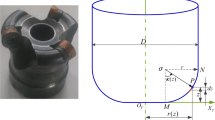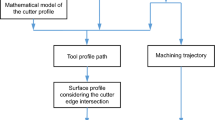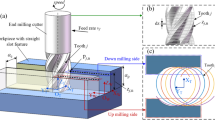Abstract
The paper deals with the prediction of the 3D surface topography obtained in 5-axis milling in function of the machining conditions. For this purpose, a simulation model for the prediction of machined surface patterns is developed based on the well-known N-buffer method. As in sculptured surface machining the feed rates locally vary, the proposed model can be coupled to a feed-rate prediction model. Thanks to the simulation model of 3D surface topography, the influence of the machining strategy on resulting 3D surface patterns is analyzed through an experimental design. Results enhance the major influence of the tool inclination on 3D topography. Surface parameters used in the study are strongly affected by the variation of the yaw angle. The effect of the feed rate is also significant on amplitude parameters. Finally, the analysis brings out the interest of using surface parameters to characterize 3D surface topography obtained in 5-axis milling.
Similar content being viewed by others
References
Dong WP, Sullivan PJ, Stout KJ (1994) Comprehensive study of parameters for characterizing three dimensional surface topography IV: parameter for characterising spatial and hybrid properties. Wear 178:45–60
Ganti S, Bhushan B (1995) Generalized fractal analysis and its applications to engineering surfaces. Wear 180:17–34
Thomas TR, Rosen BG, Amini N (1999) Fractal characterisation of the anisotropy of rough surfaces. Wear 232:41–50
Roques-Carmes C, Bodin N, Monteil G, Quiniou JF (2001) Description of rough surface using conformal equivalent structure concept. Part 1: stereological approach. Wear 248:82–91
Roques-Carmes C, Bodin N, Monteil G, Quiniou JF (2001) Description of rough surface using conformal equivalent structure concept. Part 2: numerical approach. Wear 248:92–99
Saravanakumar P, Manesh KK, Singaperumal M, Ramamoorthy B (2009) Modelling of fluid continuum considering 3D surface parameters in hydraulic assemblies. Precis Eng 33:99–106
Blunt L, Jiang X (2003) Advanced techniques for assessment surface topography: development of a basis for 3D surface texture standards “surfstand”. Kogan Page, London, ISBN 1903996112
Novovic D, Dewes RC, Aspinwall DK, Voice W, Bowen P (2004) The effect of machined topography and integrity on fatigue life. Int J Mach Tools Manuf 44:125–134
Ramos AM, Relvas C, Simões A (2003) The influence of finishing milling strategies on texture roughness and dimensional deviations on the machining of complex surface. J Mater Process Technol 136:209–216
Benardos PG, Vosniakos GC (2003) Predicting surface roughness in machining: a review. Int J Mach Tools Manuf 43:833–844
Kang MC, Kim KK, Lee DW, Kim JS, Kim NK (2001) Characteristics of inclined planes according to the variations of the cutting direction in high-speed ball-end milling. Int J Adv Manuf Technol 17:323–329
Baptista R, Antune Simoes JF (2000) Three and five axes milling of sculptured surfaces. J Mater Process Technol 103:398–403
Axinte DA, Dewes RC (2002) Surface integrity of hot work tool steel after high speed milling-experimental data and empirical models. J Mater Process Technol 127:325–335
Ko TJ, Kim HS, Lee SS (2001) Selection of the machining inclination angle in high-speed ball end milling. Int J Adv Manuf Technol 17:163–170
Jung JY, Kim CM, Ko TJ, Chung WJ (2004) Optimization for improvement of surface roughness in high speed machining. Curr Adv Mech Des Prod 8:953–960
Kim BH, Chu CN (1999) Texture prediction of milled surfaces using texture superposition method. Comput Aided Des 31:485–494
Bouzakis KD, Aichouh P, Efstahiou K (2003) Determination of the chip geometry, cutting force and roughness in free form surfaces finishing milling, with ball end tools. Int J Mach Tools Manuf 43:499–514
Toh CK (2004) Surface topography analysis in high speed finish milling inclined hardened steel. Precis Eng 28:386–398
Chen JS, Huang YK, Chen MS (2005) A study of the surface scallop generating mechanism in the ball-end milling process. Int J Mach Tools Manuf 45:1077–1084
Liu N, Loftus M, Whitten A (2005) Surface finish in high speed, ball nose milling applications. Int J Mach Tools Manuf 45:1152–1161
Quinsat Y, Sabourin L, Lartigue C (2008) Surface topography in ball en milling process: description of a 3D surface roughness parameter. J Mater Process Technol 195:135–143
Ehmann KF, Hong MS (1994) A generalized model of the surface generation process in metal cutting. Annal CIRP 43:483–486
Li SJ, Liu RS, Zhang AJ (2002) Study on an end milling generation surface model and simulation taking into account of the main axle's tolerance. J Mater Process Technol 129:86–90
Gao T, Zhang WH, Qiu K, Wan M (2006) Numerical simulation of machined surface topography and roughness in milling process. J Manuf Sci Eng 128:96–103
Zhang WH, Tan G, Wan M, Gao T, Bassir D (2008) A new algorithm for the numerical simulation of machined surface topography in Multi axis ball-end milling. J Manuf Sci Eng 130:11003-1–11003-11
Lavernhe S, Quinsat Y, Lartigue C, Meyer R (2008a) NC-simulation for the prediction of surface finish in 5-axis high-speed machining. 3rd CIRP International Conference on High Performance Cutting, Dublin (Ireland), 1, pp 387–396, 12–13 June 2008
Lavernhe S, Tournier C, Lartigue C (2008) Kinematical performance prediction in multi-axis machining for process planning optimization. Int J Adv Manuf Technol 37:534–554
Author information
Authors and Affiliations
Corresponding author
Rights and permissions
About this article
Cite this article
Lavernhe, S., Quinsat, Y. & Lartigue, C. Model for the prediction of 3D surface topography in 5-axis milling. Int J Adv Manuf Technol 51, 915–924 (2010). https://doi.org/10.1007/s00170-010-2686-3
Received:
Accepted:
Published:
Issue Date:
DOI: https://doi.org/10.1007/s00170-010-2686-3




